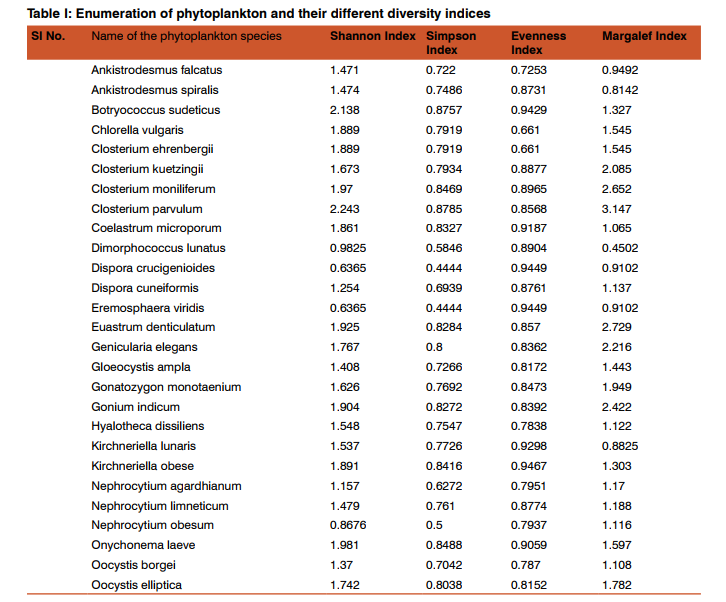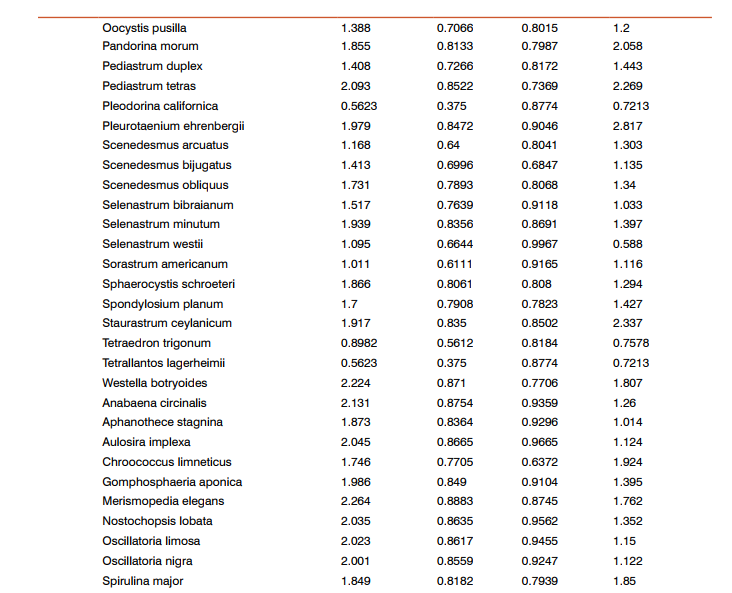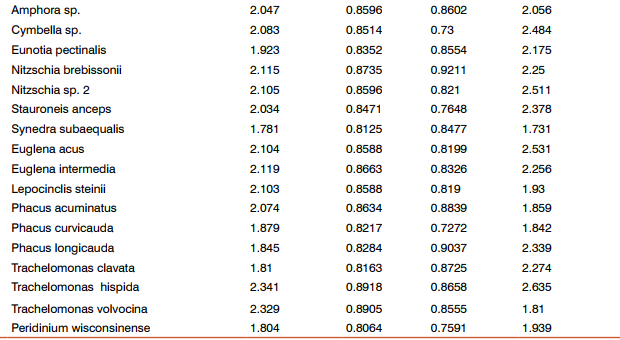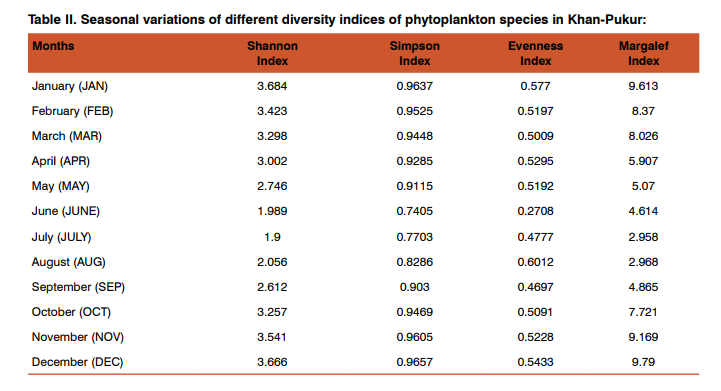IJCRR - 7(4), February, 2015
Pages: 01-07
Print Article
Download XML Download PDF
Environmental Determinants of Phytoplankton Assemblages of a Lentic Water Body of Burdwan, West Bengal, India
Author: Debjyoti Das, Sudin Pal, Jai Prakash Keshri
Category: General Sciences
Abstract:The present investigation concerns the seasonal changes of phytoplankton diversity and physico-chemical characteristic of water in a lentic water body. Diversity indices of 58 phytoplankton species and the regulatory effects of the 10 physico-chemical parameters of water on the phytoplankton diversity were assessed. The phytoplankton diversity, richness and dominance were high in winter but the evenness was high in the months of pre-summer. From the Euclidean distance of seasonal variation of phytoplankton diversity and physico-chemical parameters of water it was revealed that the phytoplankton diversity were changed with the seasonal i.e. pre-monsoon, monsoon and post-monsoon changes of physico-chemical parameters.
Keywords: Diversity indices, Euclidean distance, Khan-pukur, Physico-chemical characteristic, Phytoplankton
Full Text:
INTRODUCTION
Algae are the major primary producers in the aquatic systems and are an important food source for other organisms like zooplanktons, rotifers and fishes etc. They include planktonic and benthic forms. Species composition and the seasonal variations of phytoplankton in fresh water bodies are dependent on interactions between physical and chemical factors in the tropical regions. Works on phytoplankton diversity in India were carried out by several workers. Several works have been done on the seasonal variations of phytoplankton from lakes and small water bodies in relations to the physiochemical parameters from India including West Bengal also (Roy, 1955; Jana, 1973; Jana et al., 1981; Mukhopadhyay et al., 1997; Ali et al., 1999; Chakraborty and Das, 2004; Chakraborty et al., 2004; Balasingh and Shamal, 2007; Chattopadhyay and Banerjee, 2007; Senthilkumar and Sivakumar, 2008; Goswami and Palit, 2010; Ghosh and Keshri, 2011; Das et al., 2011; Das and Keshri, 2012; Das and Keshri, 2013). India is among the countries of tropical region. Burdwan district is situated in the eastern part of the country. It is an agriculture based region and greater portion of this district is covered with fertile cultivated field and local people basically depend on this. Many small and large water bodies are there in this district and a large part of agriculture depend on the water of these water bodies. The chemical and biological manures directly leach out from this field into the water bodies and thus water chemistry become changed and therefore variable throughout the year depending on the nature of the leachates and time of leaching. This varied water chemistry directly affects the availability of the water micro-planktons of the water and have a great impact on the water kingdom also.
STUDY SITE
The district of Burdwan geographically forms part of the Gangetic plains of West Bengal and tropical region of India. This man-made, perennial wetland “Khan-Pukur”, is situated near the Korjona Village, 30 km away from Burdwan town and lies between the parallels 23° 20´ 34.50″ N to 23° 20´ 37.84″ N and 87° 53´ 17.99″ E to 87° 53´ 26.28″ E. It covers an area of 30 hectares, surround ed by cultivated land. The bank of the pond is covered by several big trees with semi aquatic wetland plants. It receives run-off water from the adjacent land. The average annual depth of water is 11ft. The water of this wetland is mainly used for agriculture.
MATERIAL AND METHODS
Measurement of Phytoplankton diversity
In the present investigation 30 hectares area was studied by choosing sites at random and the water samples were collected once in a month during the time period of January 2010 to December 2010 between 9-11 a.m. 1% Lugols’ Iodine solution and 10% Formalin solution were used to preserve the phytoplankton (PHYTO) samples. The identification and quantitative analysis were done by using Carl Zeiss Axiostar microscope with photo micrometry Nikon camera attachment.
Collection and Analysis of Water Samples
Water samples were collected in air tight Polyvinyl chloride (PVC) bottles. The pH, Temperature (TEMP), Conductivity (COND), Total Dissolved Solids (TDS), Salinity (SAL) were measured by PCS Testr- 35 and the other parameters such as dissolve oxygen (DO), Biological Oxygen Demand (BOD), Phosphate (PO4 +) Nitrate (NO3 - ) and Potassium (K+) were tested by following standard methods of American Public Health Association (APHA, 1995; Jadav and Jogdand, 1993; C.P.C.B. Publication, 1978).
Statistical Methods
The statistical analysis like measurement of Shannon’s index, Simpson’s index, Pielou’s index, Margalef’s index were done using PAST 2.07software, the correlation matrix and single linkage Eucladian distance of different variables were performed by STATISTICAw 580 software.
RESULTS
The species wise diversity represented in the Table 1. Total 73 phytoplankton species were found and identified by several monographs (Turner, 1892; Hustedt, 1930; Philipose, 1967; Pal and Mukhopadhyay, 2013; Wehr and Sheath, 2003). Among the 73 taxa recorded class Chlorophyceae represented by maximum number of 46 genera, Cyanophyceae by 10 genera, Euglenophyceae about 9 genera, Bacillariophyceae 7 genera and Dinophyceae only one genus. Seasonal variations of different diversity indices of phytoplankton species in pond are depicted in Table-2. The highest richness of phytoplankton were shown in December followed by January, November, and February that means in the winter the species richness was highest and lowest in July and August at the time of monsoon. The Simpson’s dominance index was also highest in winter seasons including the conjugative months December, January, and November. From the different physico-chemical parameters point of view (Table III) average water temperature was 31.25°C in summer, 26°C in monsoon and 24.75°C in winter. The water pH was always below 7 i.e. acidic throughout the year. The case wise correlation matrix (Table IV) of all parameters with phytoplankton diversity the number of phytoplankton were significantly positively correlated (p<0.05) with SAL (r = 0.95), COND (r = 0.68) and TDS (r = 0.67). Also with the phytoplankton assemblage a significant positive correlation was found with NO3 (r = 0.90), PO4 (r = 0.92) and K (r = 0.91) as these were served as a nutrient for phytoplankton growth.
DISCUSSION
Among the phytoplankton taxa the Shannon’s general diversity as well as the species dominancy was observed the highest in Trachelomonas hispida and the lowest in Tetrallantos lagerheimii. While Selenastrum westii was the most evenly distributed species in the pond throughout the year. The Margalef’s species richness got the highest value in Closterium parvulum and the lowest in Dimorphococcus lunatus (Table I). The species richness index was varied throughout the year. The highest richness of phytoplankton were shown in December followed by January, November, and February that means in the winter the species richness was highest and lowest in July and August at the time of monsoon. The Simpson’s dominance index was also highest in winter seasons including the conjugative months December, January, and November. On the other hand the Shannon’s general diversity index was high in mainly winter season (November to February) followed by pre monsoon (February to April). But the Pielou’s evenness index was high at the pre summer time i.e. on January and December that means the phytoplankton were highly evenly distributed (Table II). From the different physico-chemical parameters point of view (Table III) average water temperature was 31.25°C in summer, 26°C in monsoon and 24.75°C in winter. The water pH was always below 7 i.e. acidic throughout the year. The big trees were present throughout bank region of the wetland and different types of aquatic plants were covered a big portion of the water body. So, for the lower penetration of light which causes low photosynthesis rates than respiration rate, the carbon dioxide makes the water more acidic (Pal and Mukhopadhyay, 2013). Also decomposition litter also cause for the same. The pH was high during winter time and low in monsoon season due to heavy rainfall. The specific conduction, total dissolve solids and salinity were high and near about same in late monsoon, winter and early summer (September to May) and low in late summer and early monsoon (June to August). The dissolve oxygen was also high in winter (October to February) may be due to the presence of high phytoplankton diversity and for that higher photosynthesis rate was noticed. Increased of temperature and solar radiation increased primary productivity added with respiration rate and decomposition rate increased the BOD value high in summer and monsoon (March to September). The phosphate, nitrate and potassium were higher in November to February and due to dilution factor of heavy rainfall all three parameters were lowest in June to September. The case wise correlation matrix (Table IV) of all parameters with phytoplankton diversity the number of phytoplankton were significantly positively correlated (p<0.05) with SAL (r = 0.95), COND (r = 0.68) and TDS (r = 0.67). Also with the phytoplankton assemblage a significant positive correlation was found with NO3 (r = 0.90), PO4 (r = 0.92) and K (r = 0.91) as these were served as a nutrient for phytoplankton growth. But s significant negatively correlation was observed with temperature and BOD. As in a high temperature the photosynthetic rate, enzymatic activities were decreased and may be for which the growth rate of phytoplankton were suppressed. High BOD means low dissolve oxygen, which was decreased the respiration rate, resulted phytoplankton growth was limited. The single linkage Euclidean distance graph (Figure Ia) significantly shown that phytoplankton diversity were much more similar in October to March that is late monsoon, winter and early summer and this type of relations were also observed in April -September excluding July and August, the full monsoon time, resulted different diversity pattern. On the other hand the obtained single linkage Euclidean distance graph (Figure Ib) of physicochemical parameter of water was showed near about exact same pattern of similarity as like as phytoplankton diversity graph. That means the macrophyte diversity of Khan-Pukur was changed along with the changes of physico-chemical parameters of water wetland.
CONCLUSION
To the sum up, form the present study, a differentiation between phytoplankton diversity and hydrology was recorded during the water sample collection throughout the year from the study site. Above study indicates a significant role in anthropogenic and agricultural activity of a eutrophic water body. The presence of several rare or uncommon taxa as well as diverse flora signify the restoration of such types of water bodies from the irrigation waste in the tropical regions which take part in the enrichment of the water biodiversity. However, further study should put forward for better illumination for the relation between aquatic micro-flora and water ecology.
ACKNOWLEDGEMENT
The authors express their deep sense of gratitude to Head, Department of Botany, The University of Burdwan, West Bengal for providing laboratory facilities. Authors acknowledge the immense help received from the scholars whose articles are cited and included in references of this manuscript. The authors are also grateful to authors / editors / publishers of all those articles, journals and books from where the literature for this article has been reviewed and discussed.




References:
Ali MB, Tripathi RD, Rai UN, Pal A, Singh SP. Physico-chemical characteristics and pollution level of lake Nainital (U.P., India): Role of macrophytes and phytoplankton in biomonitoring and phytoremediation of toxic metal ions. Chemosphere 1999; 39(12): 2171-2182. American Public Health Association. Standard Methods for the Examination of water and waste water, 19th edition, APHA: Washington DC; 1995. Balasingh GSR, Shamal VPS. Phytoplankton Diversity of a Perennial Pond in Kanyakumari District. Journal of Basic and Applied Biology 2007; 1(1): 23-26. Central Pollution Control Board. Scheme of Zoing and classification of India Rivers, Estuaries and Coastal water (partI. Sweet water): ADSORBS/3/1978-79, Central Pollution Control Board Publication: Delhi; 1978. Chakraborty D, Das SK. Seasonal cycle of phytoplanktons and macrophytes in the river Jalangi. Environment and Ecology 2004; 22(2): 480-481. Chakraborty I, Dutta S, Chakraborty C. Limnology and plankton abundance in selected beels of Nadia district of West Bengal. Environment and Ecology 2004; 22: 576-578. Chattopadhyay C, Banerjee TC. Temporal changes in environmental characteristics and diversity of net phytoplankton in a freshwater lake. Turkish Journal of Botany 2007; 31(4): 287-296. Das D Keshri JP. Desmids of Khechiperi Lake, Sikkim Eastern Himalaya. Algological Studies 2013; 143: 27-42. Das D Keshri JP. Coccal Green algae from Bitang-cho Lake (a high altitude lake in Eastern Himalaya). Indian Hydrobiology 2012; 15(2): 171-182. Das D, Mustafa G, Keshri JP. Contributions to our knowledge of unicellular and colonial green algae belonging to the orders Volvocales and Tetrasporales (Chlorophyta) of Burdwan, West Bengal, India. Journal of Economic and Taxonomic Botany 2011; 35(1):218-223. Ghosh S, Keshri JP. Assessment of phytoplankton diversity and dynamics of a lentic water body of Belur rail station area, with reference to pollution status. Environment and Ecology 2011; 29(1): 232-234.Goswami G, Pal S, Palit D. Studies on the Physico-Chemical characteristics, Macrophyte Diversity and their Economic Prospect in Rajmata Dighi: A wetland in Cooch Behar District, West Bengal, India. NeBIO 2010; 1(3): 21-26. Hustedt F. Bacillariophyta (Diatomeae). In Die SüsswasserFlora Mitteleuropas, Pascher, A. Heft 10, Gustav Fischer, Jena; 1930. Jadav HV, Jogdand SN. Environmental, Chemical and Biological analysis, Himalayan Publishing House, New Delhi; 1993. Jana BB. Seasonal periodicity of plankton in a freshwater pond in West Bengal, India. International Revue gesamten Hydrobiologie Hydrography 1973; 58(1), 127-143. Jana BB, De UK, Das RN. Environmental-factors affecting the seasonal-changes of net phytoplankton in 2 tropical fish ponds in India. Swiss Journal of Hydrology 1981; 42(2): 225-246. Moitra SK, Bhattacharya BK.. Some hydrological factors affecting plankton production in a fresh pond in Kalyani, West Bengal, India. Ichthyologica 1965; (4): 8-12. Mukhopadhyay SK, Ghosh A, Roy S. Primary productivity of phytoplankton in two freshwater bodies at Chinsurah in summer. Geobios 1997; 24(1): 47-50. Pal S, Chattopadhyay B, Mukhopadhyay SK. Variability of carbon content in water and sediment in relation with physico-chemical parameters of East Kolkata Wetland Ecosystem: A Ramsar Site. NeBIO 2013; 4(6): 70-75. Philipose MT. Chlorococcales. Indian Council for Agricultural Research: New Delhi; 1967. Roy HK. Plankton ecology of the river Hooghly at Palta, West Bengal. Ecology 1955; 169-175. Senthilkumar R, Sivakumar K. Studies on phytoplankton diversity in response to abiotic factors in Veeranam lake in the Cuddalore district of Tamil Nadu. Journal of Environmental Biology 2008; 29(5): 747-752. Turner WB. The fresh-water algae (Principally Desmidieae) of East India. K. Sv. Vetensk. Acad. Handl 1892; 25(5): 1-187 pls. 1-23. Wehr JD, Sheath RG. Freshwater algae of North America, Academic Press: San Diego, CA; 2003.
|






 This work is licensed under a Creative Commons Attribution-NonCommercial 4.0 International License
This work is licensed under a Creative Commons Attribution-NonCommercial 4.0 International License